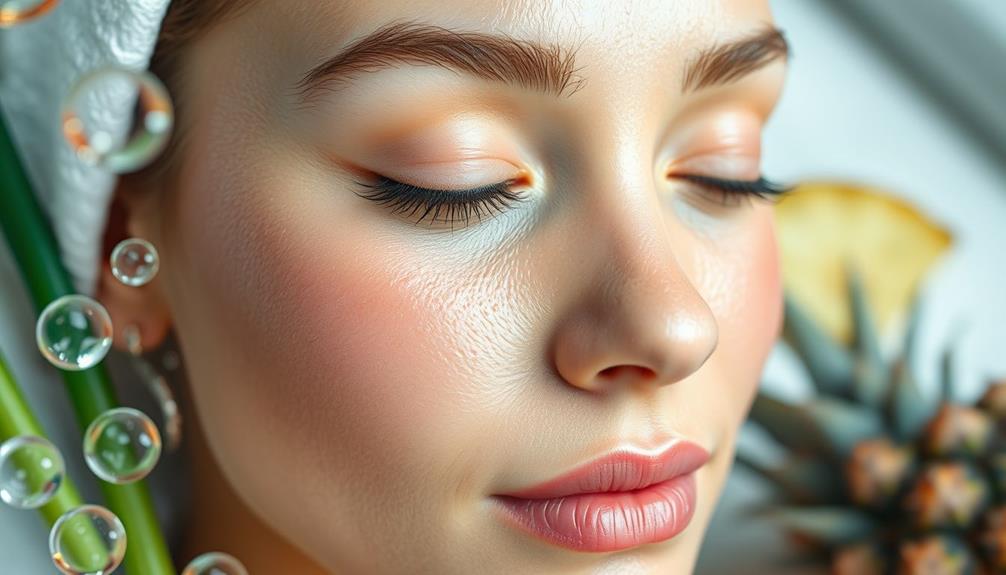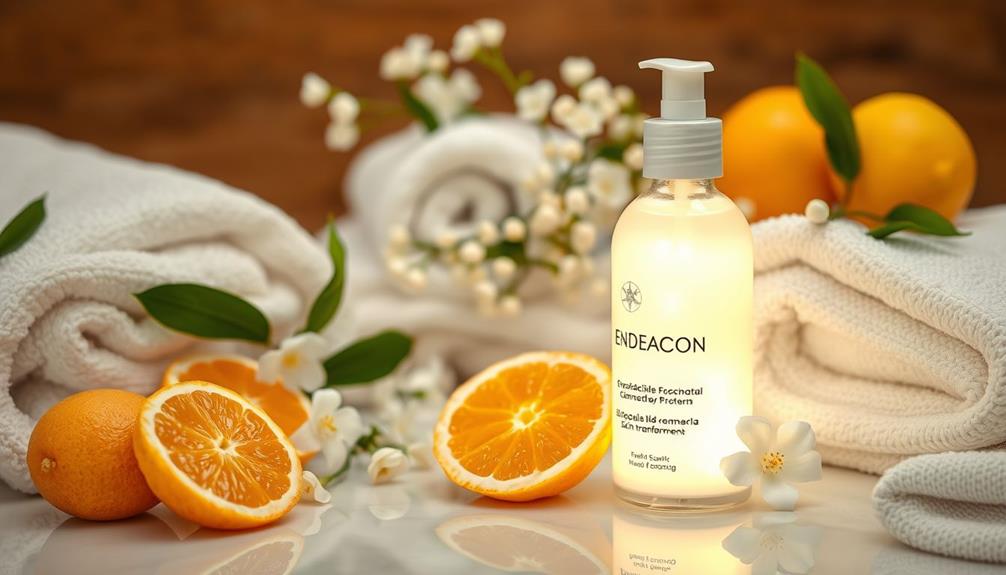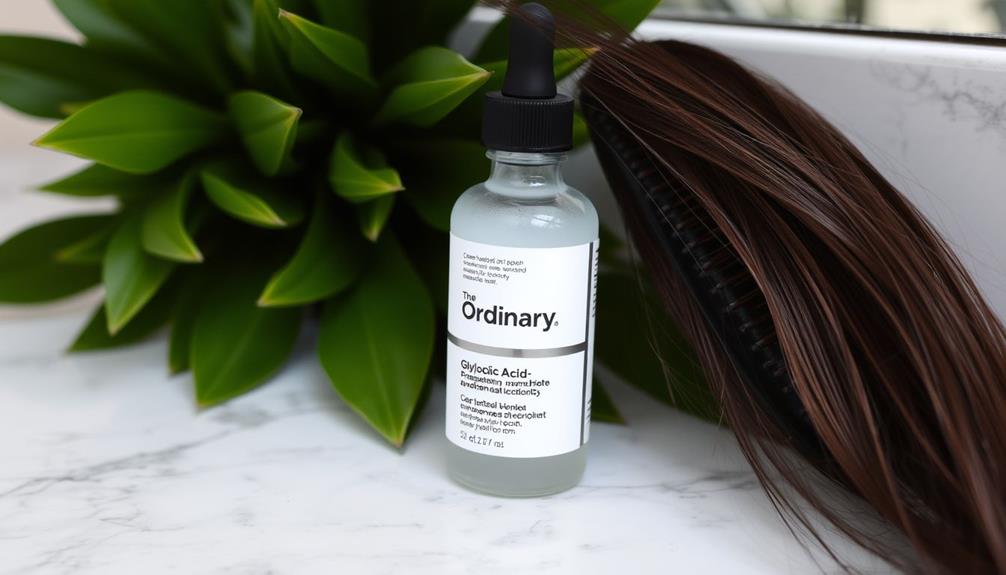Glycolic acid can transform your skin. it effectively removes dead cells, revealing a more radiant complexion by accelerating cell turnover. This potent ingredient stimulates collagen production, reducing wrinkles and improving elasticity. Additionally, it can help in evening out skin tone and reducing acne breakouts by unclogging pores. It is recommended to start with a lower concentration to prevent irritation and always remember to apply sunscreen after use. Adding glycolic acid to your skincare routine can lead to noticeable improvements in skin texture and overall health. There is still more to learn about its benefits and effectiveness.
Key Takeaways
- Glycolic acid is an effective AHA that exfoliates dead skin cells, promoting a smoother skin texture and faster cell turnover.
- It stimulates collagen production, reducing fine lines and wrinkles while enhancing skin elasticity for a more youthful appearance.
- Regular use can fade dark spots, even out skin tone, and prevent acne by unclogging pores.
- Glycolic acid enhances moisture retention in the skin, leading to improved hydration and overall skin health.
What Is Glycolic Acid?

Glycolic acid, an alpha-hydroxy acid derived from sugarcane, is celebrated for its powerful exfoliating properties and ability to improve your skin's texture and tone.
It's the smallest AHA, which means it penetrates deeper into your skin, effectively dissolving the bonds between dead skin cells. This action promotes faster cell turnover, helping you reveal fresher skin underneath.
Additionally, incorporating essential oils for skin health, like those with antimicrobial properties, can complement glycolic acid's effects and enhance your skincare routine natural alternatives to chemical products.
Incorporating glycolic acid into your skincare routine can be particularly beneficial if you struggle with acne or hyperpigmentation.
By sloughing off dead skin cells, it helps prevent clogged pores, reducing breakouts and making your skin look clearer. Additionally, its exfoliating effects can diminish the appearance of dark spots and uneven skin tone over time.
You'll find glycolic acid in various skincare products, including cleansers, toners, serums, and chemical peels.
Typically, at-home products feature concentrations ranging from 5% to 10%, making it accessible for most skincare enthusiasts.
If you're looking to enhance your skin texture and achieve a more radiant complexion, glycolic acid could be a game changer in your routine.
Key Benefits for Your Skin
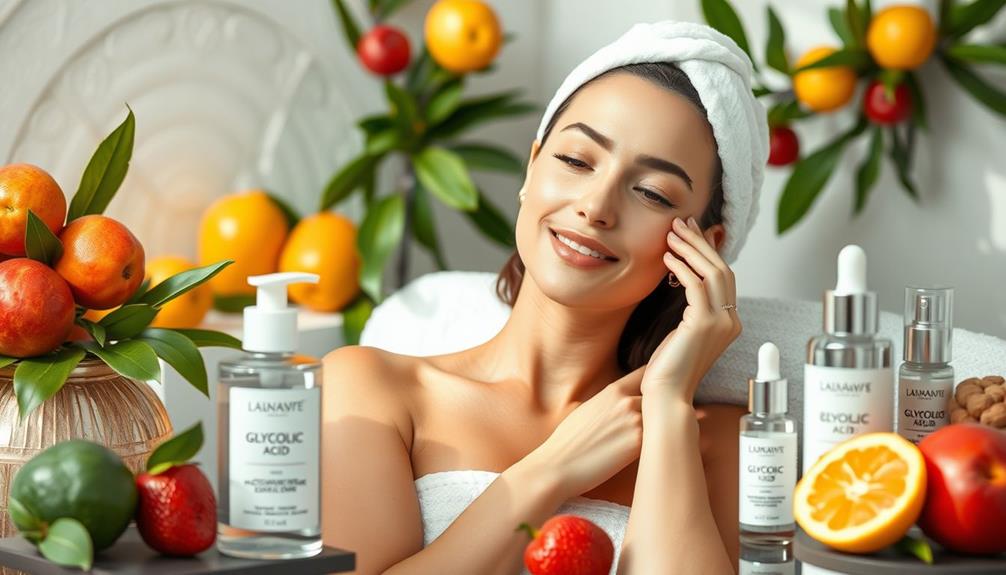
By incorporating glycolic acid into your routine, you can enjoy a range of key benefits that enhance your skin's overall health and appearance. This powerful ingredient is known for its ability to transform your skin by promoting cell turnover and exfoliating dead skin cells, paving the way for a brighter and smoother complexion.
Additionally, combining glycolic acid with essential oils like Lavender can support skin health and provide a soothing effect, as seen in aromatherapy techniques.
Here are some key benefits you can expect:
- Improved skin texture: Glycolic acid smooths the surface, making it feel soft and refined.
- Reduced fine lines: By stimulating collagen production, it helps your skin look firmer and more youthful.
- Faded dark spots: Regular use can diminish hyperpigmentation for a more even skin tone.
Additionally, glycolic acid enhances hydration by improving moisture retention, keeping your skin plump and radiant.
With these benefits, incorporating glycolic acid into your skincare regimen can lead to noticeable improvements in your skin's appearance and overall health.
How Glycolic Acid Works

Glycolic acid works by breaking down the bonds between dead skin cells, making it easier for your skin to shed them and reveal a fresh layer underneath.
This process not only promotes exfoliation but also stimulates collagen production, enhancing your skin's elasticity and firmness.
Additionally, incorporating antioxidants like those found in rooibos tea benefits can further improve your skin's health.
As a result, you can expect smoother, healthier skin with regular use.
Exfoliation and Skin Renewal
As an effective alpha-hydroxy acid (AHA), glycolic acid dissolves the bonds between dead skin cells, making it easier for your skin to shed them and reveal a smoother surface.
This process of exfoliation not only refreshes your complexion but also promotes skin renewal, leading to significant improvements over time.
Incorporating glycolic acid into your routine can be as transformative as adopting eco-friendly chemicals for skincare, enhancing your overall skin health.
Here are some key benefits of using glycolic acid in your skincare routine:
- Accelerates cell turnover for fresher, brighter skin.
- Reduces the appearance of fine lines and wrinkles.
- Evens out uneven skin tone for a more uniform complexion.
Collagen Stimulation Effects
Collagen stimulation occurs when glycolic acid enhances fibroblast activity in the dermis, reinforcing the skin's structure and elasticity. This powerful alpha-hydroxy acid promotes collagen production, which is essential for maintaining a firm and youthful appearance.
As you use glycolic acid, its exfoliation effects help to reduce collagen breakdown caused by aging and sun damage, leading to improved skin texture over time. Additionally, incorporating gentle yoga stretches before bedtime can enhance overall relaxation, supporting your skin's health during your skincare routine yoga for back pain relief.
Regular application of glycolic acid can greatly increase collagen density, making your skin look plumper and more vibrant. By promoting cell turnover, glycolic acid encourages the production of new collagen fibers, which effectively smooths out fine lines and wrinkles.
The small molecular size of glycolic acid allows it to penetrate deeply, maximizing its impact compared to other treatments. Incorporating glycolic acid into your skincare routine not only enhances collagen synthesis but also improves overall skin elasticity.
You'll notice that your skin feels firmer and more resilient as you regularly exfoliate and stimulate collagen production. With consistent use, you can achieve a more youthful appearance, enjoying the benefits of healthy, revitalized skin.
Application Methods and Tips

To get the best results from glycolic acid, start with a low concentration and gradually increase usage to find what your skin can tolerate. Begin with a 5% solution, applying it 1-2 times a week. Always perform a patch test on a small area of skin to check for adverse reactions, especially if you have sensitive skin.
Incorporating self-exploration through body awareness can enhance your overall skincare routine by promoting a deeper connection with your skin's needs.
For effective application methods, consider these tips:
- Use glycolic acid cleansers daily for gentle exfoliation.
- Incorporate peel-off masks or at-home peel pads up to twice weekly for more intensive treatments.
- Stick to your evening routine for application, reducing sun sensitivity.
Potential Side Effects
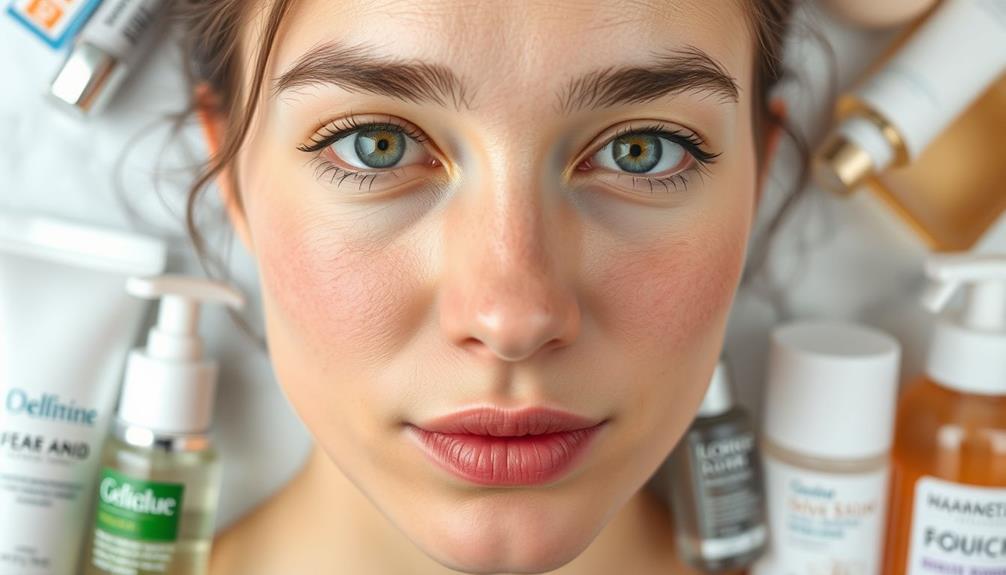
Using glycolic acid can lead to some common side effects, including redness, tingling, and peeling, especially when you're first starting out. It's essential to be aware of how your skin reacts, particularly if you have sensitive skin. Here's a quick overview of potential side effects and considerations:
| Side Effect | Description | Recommendation |
|---|---|---|
| Redness | Temporary redness may occur post-application. | Use a gentle moisturizer afterward. |
| Tingling | A slight tingling sensation is normal. | Start with lower concentrations. |
| Peeling | You may experience mild peeling as skin exfoliates. | Limit use to a few times a week. |
| Sun Sensitivity | Increased sensitivity to sunlight is possible. | Always apply sunscreen daily. |
| Irritation | Overuse can cause severe irritation or burns. | Consider patch testing before use. |
If you have active skin conditions like eczema or rosacea, you should avoid glycolic acid, as it may exacerbate irritation. By being cautious and paying attention to your skin's reactions, you can enjoy the benefits of glycolic acid while minimizing side effects.
Recommended Products and Usage

Glycolic acid products come in various formulations, making it easy to find the right one for your skincare routine. To get started, it's best to choose lower concentrations of glycolic acid, around 5-10%, to evaluate your skin tolerance. As your skin adjusts, you can gradually increase the frequency and concentration.
Here are some recommended products to take into account:
- SkinCeuticals Glycolic 10 Renew Overnight: Provides gentle overnight exfoliation.
- L'Oréal Paris Revitalift Triple Power 10% Pure Glycolic Acid Serum: Affordable with hydrating aloe juice.
- Glycolic Acid Cleansers: Ideal for daily use and consistent exfoliation.
For best results, apply glycolic acid in the evening and always use daily sunscreen during the day to protect your skin from increased sun sensitivity.
Look for product formulations with a pH level between 3 and 4 to guarantee effectiveness. Also, keep in mind that using glycolic acid alongside other strong actives like retinoids or vitamin C can lead to irritation, so it's best to avoid combining them.
Frequently Asked Questions
What Does Glycolic Acid Do to Broken Skin?
Glycolic acid's harshness heightens hazards for broken skin. It can irritate, inflame, and impede healing, leading to potential burns. It's best to skip glycolic acid until your skin's fully healed for safer, smoother recovery.
What Does Glycolic Acid Actually Do?
Glycolic acid gently exfoliates your skin, removing dead cells and revealing a brighter complexion. It boosts collagen production, enhances elasticity, and helps unclog pores, making it effective for reducing fine lines and preventing acne.
Does Glycolic Acid Help Heal Skin?
Yes, glycolic acid helps heal your skin. It accelerates cell turnover, fades dark spots, and reduces blemishes. Regular use stimulates collagen production, enhancing elasticity and firmness, ultimately promoting a healthier, more radiant complexion.
What Do Dermatologists Say About Glycolic Acid?
Dermatologists praise glycolic acid for its ability to improve skin texture, treat acne, and reduce fine lines. They recommend starting with lower concentrations at home, gradually increasing usage while emphasizing the importance of sunscreen protection.
Conclusion
Incorporating glycolic acid into your skincare routine can feel like opening a hidden door to a brighter, smoother complexion.
With its ability to exfoliate and rejuvenate, it transforms your skin much like a master artist revealing a masterpiece hidden beneath layers of paint.
Just remember to ease into its use, listen to your skin, and embrace the journey toward radiance.
With patience and care, you'll find that glycolic acid can be your skin's best-kept secret.

